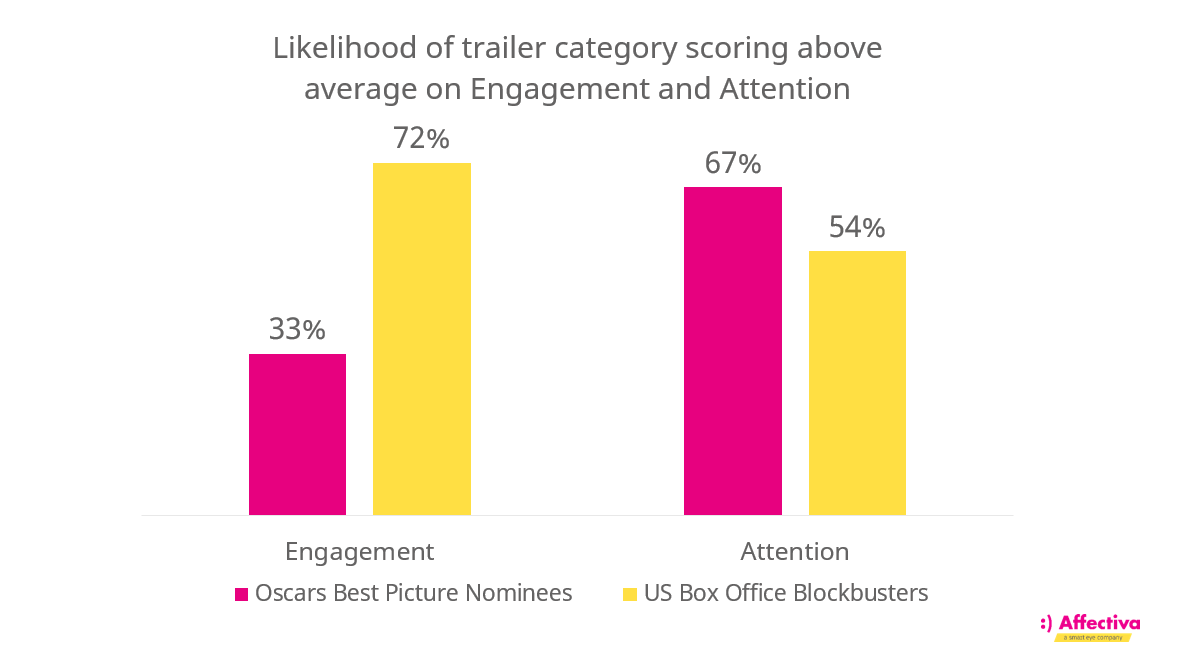2023 in the film industry marked some remarkable highlights: this was the year of “Barbenheimer” coming head-to-head on the same opening weekend, the strikes with the Writer’s Guild of America and SAG-AFRA and seeing a lot more fuchsia and hot pink on trend in the shops – whether that’s because of Pantone’s Color of the Year or the Barbie film, you can decide.
With awards season in full swing, we continued our analysis of Oscars Best Picture Nominees with US Box Office top 10 highest grossing movies to make comparisons and see how this year’s nominees and 2023 blockbusters contribute to our list. Keeping a similar research design, we assessed trailers and teasers that were tested with Affectiva’s Emotion AI technology. Using the trailers as a proxy for the emotional tone and journey of the films, we conducted an analysis of those that were tested in the US market, comparing them across each other to identify meaningful trends.
Ready… set… action!
Last year, we showed that both Oscars and US Box Office Blockbusters are both able to be emotionally impactful in different ways. This year, we wanted to add upon this analysis and investigate meaningful differences between engagement and attention between the Oscars nominees and blockbusters. With our latest Attention metric taking into consideration signs of attention and inattention (think: facial occlusion, speaking, drowsiness, gazing away from the screen), we did a deep dive into the data to see whether there were any meaningful differences between emotional engagement (both positive and negative), and overall attention.
While emotional engagement is higher for blockbusters, we can see that attention is likely to be higher for Oscars nominees. This could be attributed to the trailers in our database for Oscar nominated films being a slightly shorter duration, but this difference was not significant between categories. So, although there may be a less overt emotional response towards trailers for Oscar nominated films, these trailers are still able to attract and hold high levels of viewer attention towards the content.
When we looked at the dataset for positive emotional reactions across both film categories, we saw that US Box Office blockbusters still have approximately 4x higher likelihood of evoking strong positive emotional reactions compared to Oscar Best Picture Nominees. This may be due to the nature of box office blockbusters being mainly feel-good movies, or those that are for the family, and superhero films that pack a punch or animated comedy films.
Furthermore, box office blockbusters showed higher levels of both Joy and Sentimentality – results that were quite similar to the previous year’s. Award nominees tended to gravitate more towards a higher likelihood of more negative responses, such as expressions that comprise of sadness as well as brow furrows which can indicate tension and displeasure. The following analysis below is a correspondence chart of each category (Box Office, Oscar nominees and all other trailers), mapping out different emotional state responses and the association with each category.
Overall, the data aligns to last year’s with very minor shifts. One point to note is that even though there are more blockbusters and films with comedy as a subgenre on the Oscars Best Pictures list this year – there are still more dramas in the Oscars Best Pictures nominee category compared to films that were top blockbusters, which goes a long way to explaining this pattern of responses.
The final cut
During our previous analysis, we remarked that the win of Everything Everywhere All at Once marked a cultural shift on what makes a successful film that receives an Oscars nod as it combined humor and drama together, and paired moments of tension with those of laughter. This year holds a semblance to that – having something as austere as Oppenheimer with a film like Barbie – one that appears from the advertising to be about comedy and evoking fond childhood memories, with a deeper overall lesson on self-acceptance. While there is little change within our dataset, there may still be an industry change in how we may perceive what makes for a good and thought-provoking film worthy of top box office performance and award wins.
During Sunday’s Oscars ceremony, while Oppenheimer secured the award for Best Picture (and six other Academy Awards!), viewers were treated to fantastic performances, including Billie Eilish singing What Was I Made For, who secured a win for Best Original Song, and Ryan Gosling donning bright pink singing I’m Just Ken. With Oppenheimer being the Best Picture for 2024, it will be interesting to see what trends we can uncover next year. Who will secure the Best Picture award in 2025... will it again be a box office blockbuster or an independent film? Stay tuned!
Methods: How we looked at the data
We analyzed a selection of the trailers for Oscars Best Picture nominees from 2022-2024, corresponding to films that were released in 2021-2023. Domestic Box Office top performers in 2021-2023 were also analyzed. From there, we performed a deep search in Affectiva’s database for trailers and teasers of these films that were tested with our Emotion AI technology in the US market, pulling out summary metrics and normative data for these movies.
Films that were both Box Office top performers and Oscars Best Pictures nominees were counted in each of their categories, with approximately 32 films being included for the analysis. For each film, emotional norms for every facial expression and emotional state were averaged across each category list, comparing it to each other and to our norm for all trailers tested in the US market. Lastly, for the attention comparison, we looked at summary metrics of Affectiva’s newest Attention metric, comparing the attention score for each piece of media to the average of the total media as well as taking into consideration the duration for each as content ranged from 30 seconds to over 3 minutes in length.









